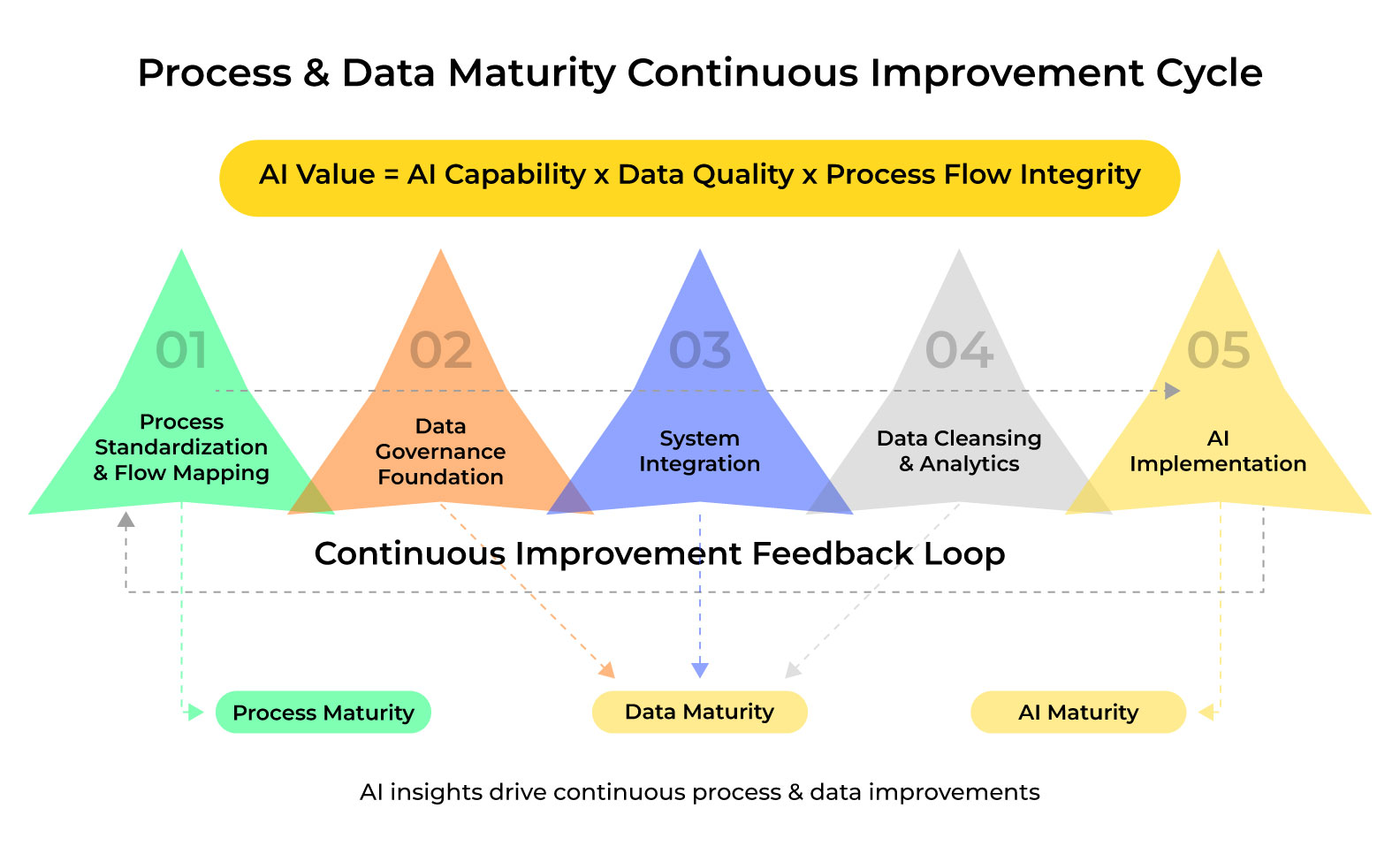

As someone who's spent years in operations, process reengineering, and data management, I've observed how organizations across industries are eager to embrace AI. And they should. AI is transformative.
We must address a vital reality: AI is only as good as the data it consumes, and data is only as good as the processes that generate it.
The more mature and standardized the process, the better the data.
The AI revolution is real and will transform how we do business. However, achieving meaningful results requires more groundwork than many realize.
Often overlooked in the AI conversation is that successful implementation follows a clear progression: process maturity enables data maturity, enabling AI maturity.
When discussing AI implementation with leadership teams, the first question is "How mature are your operational processes?" Only then can we ask, "How is your data health?" The responses often reveal significant gaps between aspirations and readiness.
The good news is that different types of AI platforms and methods can be used to strengthen process mapping and data foundation.
In future articles, I will expand on the available platforms/frameworks in this space. These choices must be made thoughtfully.
Before data can be trusted, the processes that generate that data must be consistent, documented, and followed. Process maturity clarifies how data flows from one business function to another, ensuring clean handoffs and data integrity throughout the entire operational chain.
Consider these fundamental questions:
- Are core business processes clearly defined with explicit inputs, outputs, and handoffs?
- Are data exchange points between processes clearly defined and monitored?
- Do team members understand how their process outputs become inputs for downstream processes?
- Is there clear ownership of data as it transitions between operational functions?
- Are there mechanisms to detect and address process breakdowns at handoff points?
Many organizations discover that their data challenges often occur at process boundaries. When a lead transitions from marketing to sales, a customer moves from sales to implementation, or a support issue requires product team involvement, these handoff points are where data integrity frequently breaks down. I talked about this in my podcast with Dr. Amy Cook last year.
Mature processes consider the entire operational flow and recognize that each stage impacts the next. For example:
- Marketing processes should capture lead data in formats that sales processes can seamlessly utilize.
- Sales processes should document customer requirements in ways that implementation teams can directly execute.
- Support processes should categorize issues in taxonomies that product teams can effectively analyze.
When processes are designed with these cross-functional data flows in mind, the resulting data becomes dramatically more valuable and AI-ready.
There are several ways to approach this maturity journey. One option is provided below.

1. Process Standardization & Flow Mapping: Define, document, and standardize core operational processes. Map explicit data flows between processes, identify critical handoff points, and establish clear ownership for each transition. Ensure teams understand these flows and their role in maintaining data integrity.
2. Data Governance Foundation: With standardized processes and flows in place, establish clarity around data ownership, standards for quality, and protocols for managing duplicates.
3. System Integration: Ensure core systems communicate effectively with standardized fields, consistent IDs, and reliable integrations that respect the natural flow of data through business processes.
4. Data Cleansing & Enrichment: Combine technology solutions and process improvements to address quality issues in existing data while maintaining quality (Prevent the recurrence of data pollution).
5. AI Implementation: Begin with focused AI use cases built on reliable data sets. Learn, iterate, and expand capabilities gradually.
From an operations lens, the exciting potential is evident daily. Teams want AI to predict outcomes and optimize resources. However, the path to these capabilities must follow the natural progression from process to data to AI.
Consider the customer journey: When the lead-to-opportunity process connects seamlessly with the opportunity-to-closed-won process, which flows naturally into onboarding, usage, renewal, and growth processes, the resulting data provides a complete picture that AI can use to identify patterns and make valuable predictions.
Without this process continuity, data becomes fragmented, creating blind spots that render AI insights incomplete or misleading.
While AI implementation is the end goal of this maturity journey, the business benefits begin materializing much earlier. I have stated a few obvious examples below, but feel free to create your own based on your context.
- Process Standardization Benefit Examples: 30-40% reduction in operational errors, 15-25% improvement in cycle times, and significantly higher employee satisfaction from reduced friction and clearer expectations.
- Data Governance Benefits: 20-30% reduction in time spent debating data accuracy in meetings, enhanced regulatory compliance, and the ability to make faster decisions based on trusted information.
- System Integration Benefits: 40-50% reduction in manual data entry, elimination of reconciliation tasks that often consume 15-20% of analyst time, and improved customer experience from consistent information across touchpoints.
- Data Quality Benefits: 10-15% increase in conversion rates from more accurate targeting, 25-35% reduction in missed opportunities from incomplete data, and enhanced ability to understand customer segments.
- Analytics Infrastructure Benefits include a 30-40% faster response to market changes, 20-25% more effective resource allocation, and democratizing data-driven decision-making across the organization.
These "along the way" benefits often deliver ROI that more than justifies the investment required for the entire journey, making AI capabilities a bonus rather than the sole justification. AI Implementation is a journey, and business outcomes are the destination.
The most important insight about meaningful AI implementation is that it's fundamentally an operational maturity journey. This measured approach consistently delivers better results. Companies making the most significant strides with AI today often invest time in creating seamless process flows that generate consistent, high-quality data.
The potential for AI to transform operations is genuinely exciting. The ability to predict behavior, personalize at scale, and optimize resources in real-time creates tremendous opportunities. The key to maximizing this potential lies in understanding an expanded equation:
AI Value = AI Capability × Data Quality × Process Flow Integrity.
The AI revolution is arriving in stages, each requiring corresponding levels of operational maturity. By focusing on building that foundation now, positioning yourself to leverage AI's full potential as the technology continues to evolve becomes possible.
AI can help move operations from Reactive to Proactive entities. The ability to answer, “What will happen next?†based on what we see in current data is closer than ever. Is your organization ready?


